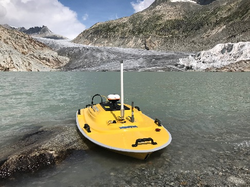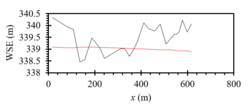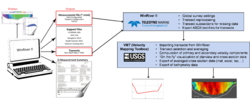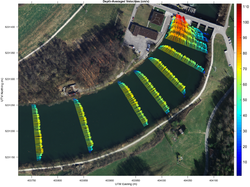Particle image velocimetry (PIV)
Contents
Quick summary
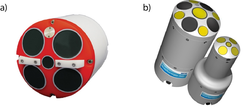
Developed by: Various Companies
Date:
Suitable for the following [[::Category:Measures|measures]]:
Introduction
Particle Image Velocimetry (PIV)
The particle image velocimetry (PIV), is an optical technique to measure the velocity of a fluid by measuring the velocity of the movement of particles transported in this fluid assuming that the particles are transported with the fluid without losses or disturbances.
The main devices used for this technique are:
- A source of light (for PIV usually a laser, however strong LED lights become more popular)
- At least one camera (in case of a 3D or volume measurement up to at least 4 cameras)
- Synchronizer to be able to automatically synchronize the camera (times when the pictures are taken) with the laser, otherwise, the pictures would not be properly illuminated
- Software for evaluation of the results
- Mostly also tracer particles as seeding
PIV is an instantaneous method to measure the flow. The main set-up includes usually a laser as a source of light (see Figure 63). With this laser, a so called laser sheet, a plain area within the fluid which is enlightened with the laser is created. All particles transported with the fluid are supposed to reflect the light and become visible like that. This effect can be supported by the use of special tracer particles (which are quite costly, so this is only recommended for lab use).
A camera takes pictures of the moving particles in predefined very short time intervals t. Based on the known t the flow velocity can be calculated using special algorithms to evaluate the movement of the seeding points visible in the picture. The evaluation of the pictures uses an Eulerian’ approach. To be able to evaluate the distances on the pictures the system needs to be calibrated. As both, the time between the two pictures as well as the distance one particle has moved comparing these pictures the particle and hence the fluid velocity can be calculated.
To be able to achieve good results it is necessary to mind certain rules such as that one particle on the resulting picture should have the size of approx.. 2-3 pixel etc. It is highly recommended to get a detailed view into the literature (i.a. Raffel et al 2007) before starting with a measurement.
The PIV can be bought as a complete system, usually including the software. Different companies such as ILA Laser applications, Dantec or LaVision offer this possibility including support. Some research institutions and universities also develop their own codes for post-processing depending on their needs or build the laser or camera system on their own.
Large Scale PIV (LS-PIV) or Airborne Image Velocimetry (AIV)
Based on the idea of PIV the so called Large Scale PIV (LS-PIV) or Airborne Image Velocimetry (AIV) was developed. As “Large Scale” with the increasing technical possibilities became a quite wide meaning the term AIV is more correct nowadays and used hereinafter.
The measurement and evaluation technique is basically the same set-up and underlying theory as PIV and adapts this for use on large scale mainly in the field. As mentioned above the term large scale is not defined, generally, it means more than lab size with about max. 1.5m x 1.5m for very good conditions. Such as a PIV the AIV is an optical system used to measure flow velocities, other than the PIV mainly surface velocities in 2D.
Instead of Laser as a source of light, the AIV uses the sun. This might become a problem for the evaluation of the pictures when direct sun is present, as reflections will affect the quality of the results.
The camera is often mounted on a UAV to ensure a sufficient size of the pictures taken as a result of greater distance and angle (Figure 64). Seeding is recommended for a sufficient quality of results. As the seeding, other than for the use with PIV, is used in a natural environment and most likely it will not be possible to collect it back behind the area of interest it is necessary to use seeding which is biodegradable such as wood chips or maize flips (packing material). Any other material which is biodegradable and available can be used as well as long as it is following the flow and is visible on the pictures taken.
Application
Within the scope of FIThydro, high resolution 3D velocity, as well as bathymetry measurements, have been conducted using an ADCP mounted on a high speed remote-controlled boat at two hydropower plants (HPP) in Switzerland since the beginning of 2018. The models of the ADCP and the boat are River Pro 1200 kHz including piston style four-beam transducer with a 5th, independent 600 kHz vertical beam and Q-Boat purchased from Teledyne Marine, USA, respectively (Figure 2). An external Differential GPS (DGPS) system from A326 AtlasLink (Hemisphere) was used to accurately measure the positions of the ADCP. One set of the battery for the Q-boat allowed us to make measurements for 4 hours up to 10 hours depending on the flow velocity and field conditions i.e. temperature.
Compass calibration and moving bed tests are conducted before each ADCP measurement at the case study HPPs. The Test Case study HPP Schiffmühle is located on the 35 km long river Limmat between in Untersiggenthal and Turgi near Baden in Switzerland (see the Test Case presentation file for HPP Schiffmühle). Two transects of ADCP at each densely spaced cross-section along the river were enough but high accuracy of altitude data was required for the bathymetry measurements at the HPP and in general. The present DGPS system resulted in ±1m of errors in altitude measurements (Figure 3, black line). Therefore, use of a total station, which is time consuming, or real-time kinematic (RTK) GPS is recommended to accurately determine water surface and hence bathymetry (Figure 3, red line from total station measurements).
Furthermore, the test results from the HPP Bannwil located on River Aare in canton Bern indicated that averaging of at least 8 transects or even more at each cross-section is needed to obtain robust and smooth velocity field and accurate discharge data at highly turbulent and 3D flows occurring in rivers, turbine inlet and outlets or other hydraulic structures (see the Test Case presentation file for HPP Bannwil).
The ADCP data from both HPPs Schiffmühle and Bannwil are post-processed according to the workflow sketched in Figure 4 using the software WinRiver II (Teledyne software) and velocity mapping toolbox (VMT, Matlab based software for processing and visualizing ADCP data provided by U.S. Geological Survey). Figure 5 shows the depth-averaged velocities at the HPP Bannwil plotted with VMT. VMT can be used with the output files from Sontek ADCPs. For further data analysis and presentation on the maps like river bed changes, Q-GIS (free software) or ARC-GIS (Commercial software) are also recommended.
The present system based on the remote-controlled boat platform has advantages over the tethered boat ADCP application. These are less man-power needed, faster and more measurements in a shorter time, no flow disturbance and interference with beams and smoother movement of the boat.
Other information
The total costs for the geophone and accelerometer sensors amount to approx. 885-1'330 €. The costs for the field computer, the analog-digital-converter, and the 3G modem are approx. 5'300-6'200 €. The total costs for the Teledyne RiverPro 1200 kHz, Teledyne Q-boat and DGPS from Hemisphere Atlas link amount to approx. 22’000 €, 21’200 € and 3’340 € respectively. The costs of shipping, VAT, some mounting apparatus and long-range radio modem are excluded. For current costs of the equipment, we recommend to ask the corresponding supplier. Note that Q-boat can also house Sontek RiverSurveyor M9. Furthermore, a rugged laptop for field use is recommended.
Relevant literature
- Mueller, D.S., Wagner, C.R., Rehmel, M.S., Oberg, K.A., Rainville, F. (2013). Measuring discharge with acoustic Doppler current profilers from a moving boat (ver. 2.0, December 2013), U.S. Geological Survey Techniques and Methods, book 3, chap. http://dx.doi.org/10.3133/tm3A22.
- Simpson, M.R. (2002). Discharge measurements using a broadband acoustic Doppler current profiler. Open-file Report 2001-1, https://doi.org/10.3133/ofr011.
Links to the suppliers of equipment:
- Teledyne Marine, ADCP RiverPro: http://www.teledynemarine.com/riverpro-adcp?ProductLineID=13
- Teledyne Marine, Q-Boat: http://www.teledynemarine.com/Lists/Downloads/Q-Boat_1800_Datasheet.pdf
- Hemisphere Atlas DPS: https://hemispheregnss.com/Atlas/atlaslinke284a2-gnss-smart-antenna-1226
- Sontek ADCP M9: https://www.sontek.com/riversurveyor-s5-m9
Software for ADCP data analysis:
- Velocity Mapping Toolbox: https://hydroacoustics.usgs.gov/movingboat/VMT/VMT.shtml
- Q-GIS: https://qgis.org/en/site/
